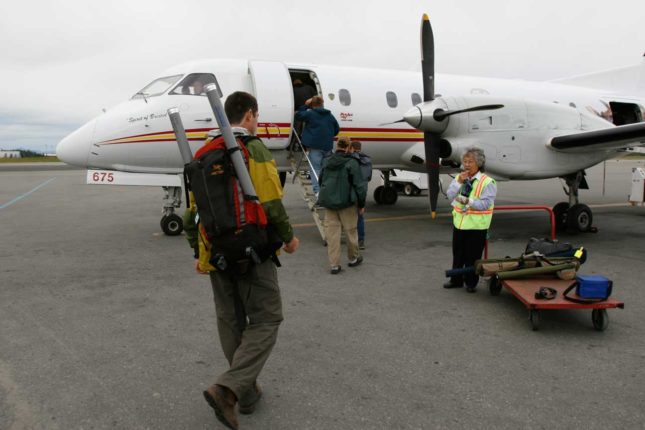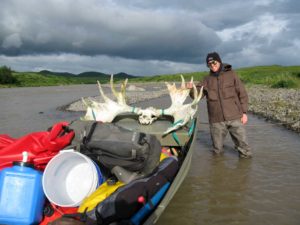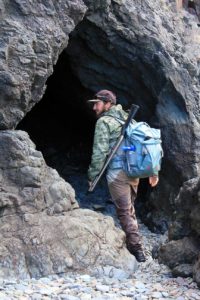Epic Blog
Machete’s Guide Gear Talk – Bags & Packs
07.06.20

Make sure you have the right gear before heading out to fly fish in remote Alaska. Photo by Johnny Quiroz.
Welcome back for the fifth installment of Machete’s Guide Gear Talk! So far we’ve talked fly fishing trip clothing, fly rods for OUTPOST, plus which reels and lines are best suited for anyone fishing at either of our two remote wilderness camps on the Alaska Peninsula. Now let’s shift our focus from clothing and fly fishing gear to technical gear. If you’re a potential new guide looking to spend a summer with us in remote Alaska this will be especially poignant.
In the first segment I referred to a list that Rus provides to all guides before the season begins. Here you will find an itemized accounting of all of the things necessary to comfortably live and effectively guide in a place that few people will ever lay eyes on. First, let’s start with what you’re going to pack all of that stuff into on your journey north; let’s talk duffels.
Bag talk
Seems kinda self explanatory really doesn’t it? What’s in a bag anyways, you just need something that zips up after all right? Nope, not even close.
The recommendation for a guide is to bring two duffels and one backpack. Preferably your large duffel is no more than 120 L. That’s huge by the way, typically the largest size option is somewhere in this ballpark. The recommendation for the smaller duffel is 90 L, also a fairly large bag by most people’s standards. Now while this might seem pretty black and white, let me share with you my own personal story of woes.
A cautionary tale
So my second season guiding in remote Alaska is set to begin and I’m in the market for a new large duffel. The one absolute requirement for me is that the bag be waterproof. I know it’s going to sit out on gravel bars and face the harsh conditions of the far north on several occasions during the course of the season, so this quality is imperative. I’m also on a budget, and if you’ve spent anytime shopping for well made waterproof duffel bags you already know that they can be very pricey.
I finally end up pulling the trigger on a NRS dry zip duffle 105 liter bag. It’s nothing fancy, no built in shoulder straps or anything like that but it’ll get the job done and the price is right for my budget. The bag comes. I remove it from the packaging and unfurl it on the floor of my living room and am immediately bewildered. This thing is a beast. It’s huge!
The body bag
Scratching my head a bit I examine the bag and see printed along its side underneath the NRS logo 105 Liters. Well, okay then, if that’s what it says then that’s what it is. Now it’s time to pack. Typically, you try to equally distribute your gear between the two duffels keeping in mind that neither can surpass 50 pounds (airline regulations). But when it comes to what will soon be dubbed the “body bag” I can’t even come close to topping it off. So, logically, I take items from my smaller duffel to fill up the big boy.
Well, when it was all said and done what I had created was a monster. Unbeknownst to me I had been doomed from the start. The 105 was a misprint that originated at the manufacturing plant. It was really 150 liters! When fully packed it was too unwieldy to lift with one arm and carry, which really became an epic pain in the ass because the only alternative was to heave it over your shoulder like some lifeless body. I learned my lesson. Better to invest in what you know works then to take a gamble on a dark horse. The solution: a 100 L black hole duffel from Patagonia. I’ll never go without shoulder straps again.

Your bags and packs may sit in the bottom of a boat, on a gravel bar or beach, all while it’s raining sideways.
Not all openings are created equal
As I mentioned before the number one quality for me is that the bag is waterproof. A secondary consideration is that the bag has backpack style shoulder straps. Although this is not a crucial feature it is so much more convenient when compared to the alternative of a single strap. Another important consideration is ease of access. During the course of a full guiding season, plus the preseason, you will need to get into and out of your duffels countless times. You will constantly be repacking and shifting items around between the two. My smaller duffel is a 75 L Watershed Colorado with a zip dry roll-top closure. And while I still like the bag for its rugged durability and simple design it can be a down right pain trying to sort through it with such a narrow opening. A zippered bag provides much more working space.
Duffle vs. Duffel
There are many top quality duffels on the market today that are specifically designed for the adventure lifestyle of a guide or jet setting angler. Here are a few that I would recommend for your consideration.
Fishpond USA makes some really bombproof products with the emphasis being focused on the fly fisherman. I’ve seen a handful of Thunderhead Duffels come off the helicopter when we’re unloading and I’m always a little envious. As I mentioned before the Patagonia Black hole line is top shelf and comes with tons of feature rich additions that make it hard to beat. Another company that I think is worth mentioning is the German based Ortlieb. I’ve seen a handful of these submersible style bags and they look indestructible. Simms, Watershed, and Sea to Summit are some other worthy contenders.

Simms, Patagonia and Fishpond gear is popular with guides and guests. Whatever brand you choose, make sure it’s worthy of remote Alaska. Photo by Stephen Hall.
Guide packs
Okay, so now you’ve squared away your two duffels, but in reality, they will spend most of the season sitting comfortably inside your tent. Safe and sheltered. Your guide pack, however, is going to be put through the same gauntlet of fire you are. It will live on your back day in and day out throughout the course of the season and you’re going to hike your ass off with it. If you don’t love it, trust me, your going to end up hating it. There’s really no middle ground.
Let’s talk about what to look for when seeking out the best pack for a guide looking to spend their summer in the wilds of the Alaska Peninsula.
First off it needs to be large, not the size of a typical day pack. The recommendation on the list is something between 30 and 40 liters. Remember, you’re going to be hauling a lot of stuff around in this pack each day you’re in the field – first aid, survival gear, extra ammo, fly boxes, fly tackle, lunches, water bottles, wading jackets, extra layers, and anything else you deem necessary to successfully guide your clients. Long story short, it’s going to be heavy. This leads us to the next thing to look for when considering a guide pack. It needs to be supportive to help you schlepp that load. Some sort of padded belt to buckle around your waist to displace that weight and take the burden off your shoulders is crucial.
No H2o Allowed
Having something that’s fully waterproof is a no brainer in my mind. In fact, a water-resistant pack with a “backpack raincoat” that you deploy during inclement weather is totally impractical for day to day guiding.
You must consider that the contents inside your pack might end up being a lifeline for you in the event something happens to you and your clients in the field. They better be well protected and dry. The last thing I would advise is having a pack that grants easy access to the contents within. Now this is where things can get tricky.
Many of the best fully submersible packs are roll tops. It’s a good design for creating an impermeable seal that also allows you to squeeze the excess air from the interior, effectively compressing the overall size of your pack. But here’s the rub. As with a roll top duffel, this design can make getting into and out of your pack difficult. This can be especially frustrating on those wet and rainy days (and there are many of them) when you end up removing half the contents of your bag for that one item buried towards the bottom. So while that air tight seal might be more reliable for keeping out the elements than a dry zip pack, you’re losing some of the convenience of a zippered opening.
To zip or not to zip
A pack with a waterproof zipper is going to allow for much easier access, and they typically have more exterior pockets which allow you to keep essential gear, like fly boxes and fishing tackle closer to hand. One considerable downside is the tendency for a zipper to fail over the course of the pack’s lifespan. Once that happens, your pack is kaput. If anything, this puts more emphasis on making sure you select a pack that is built to last.
For the past three seasons my guide pack has been a 40 L Watershed Animas. It predates my time as a remote Alaska wilderness guide, and the years of constant use have started to show. It’s a roll top, so as I mentioned before getting down to the gear packed towards the bottom often results in removing most of the contents within. Not the best. I’ve also had to make a few “upgrades” by adding a webbed waist belt and a nylon holster for my water bottle. All in all it’s served its purpose, but I’ve been seriously considering putting her to pasture and replacing it with a zippered pack.
And the winner is…
My choice for its replacement? A Fishpond Thunderhead submersible backpack. I know these babies cut the mustard because I’ve seen them first hand working as a guide up north. They’ve been the preferred choice for several of our former guides and a few of our clients as well. Completely waterproof with a waterproof zipper, and built with a range of features with the fly fishing guide in mind, they seem tailor made for the harsh conditions of the Alaska Peninsula. While it is just a hair under the 30 L recommendation at 28 L, it’s still hard to think of a better all around option that’s on the market today.
A few other considerations would be Patagonia’s StormFront pack, the Umpqua Tongass 1800, or taking a look at Simms for their latest offerings.
The golden rule
Ultimately, you need to have faith in the gear you carry with you, whether it be a fly rod, button up t-shirt, or a backpack. If you’re going to face off against the harsh conditions of the Far North as a guide or as a client, the things that you carry into the field need to be built to a higher standard if they are to be a benefit and not a hindrance. The Alaska Peninsula is a remarkably beautiful place, but it is also an unforgiving one. Is your gear up to the challenge?
Stay tuned for more gear reviews. I promise they won’t be so long! Until then friends.
Find more Machete articles here.






